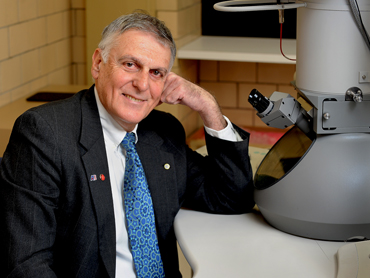Dan Shechtman presents the story of his Nobel-winning and textbook-changing discovery
02-14-12

Dan Shechtman with one of the tools of his science, a scanning transmission electron microscope in Wilhelm Hall. Larger photo. Photo by Bob Elbert.
Contacts:
Pat Miller, Lectures Program, 515-294-9935, pamiller@iastate.edu
Mike Krapfl, News Service, 515-294-4917, mkrapfl@iastate.edu
Dan Shechtman presents the story of his Nobel-winning and textbook-changing discovery
AMES, Iowa - Dan Shechtman, winner of the 2011 Nobel Prize in Chemistry, will tell the story of his 1982 discovery of quasicrystals during a public lecture on Feb. 20.
The lecture is at 7 p.m. in the Great Hall of Iowa State University's Memorial Union. A reception will follow. The events are free and open to the public.
Shechtman - an Iowa State professor of materials science and engineering, a research scientist for the U.S. Department of Energy's Ames Laboratory and the Philip Tobias Professor of Materials Science at the Technion - Israel Institute of Technology - was awarded the Nobel Prize for a discovery that forced scientists to rethink ideas about matter and its atomic arrangement.
During a sabbatical from the Technion and a two-year stint in
the United States at what's now the National Institute of
Standards and Technology, Shechtman was using a transmission
electron microscope to study rapidly solidified aluminum
alloys. His experiments revealed a structure that science said
was impossible: a pattern that when rotated a full circle
repeats itself 10 times.
In his notebook that day, Shechtman wrote "(10 Fold
???)." Later, he found the pattern was really a
five-fold rotation, but that didn't show up in the first
experiments.
"For 70 years until 1982, all crystals studied, hundreds of thousands of them, were found to be periodic," he said. "Only certain rotational symmetries are allowed in this periodic array and these are 1,2,3,4,6 and nothing else. This is why, when I saw the ten-fold rotational symmetry, I was so surprised."
Shechtman did follow-up experiments to confirm his findings and published his discovery in 1984. His work was widely questioned.
"For a long time it was me against the world," he said. "I was a subject of ridicule and lectures about the basics of crystallography. The leader of the opposition to my findings was the two-time Nobel Laureate Linus Pauling, the idol of the American Chemical Society and one of the most famous scientists in the world. For years, 'til his last day, he fought against quasi-periodicity in crystals. He was wrong, and after a while, I enjoyed every moment of this scientific battle, knowing that he was wrong."
And now that he and his discovery have been recognized with a Nobel Prize, Shechtman is advocating a more open approach to science. As he told The New York Times, "The main lesson that I have learned over time is that a good scientist is a humble and listening scientist and not one that is sure 100 percent in what he reads in the textbooks."
Shechtman's lecture is sponsored by the Ames Laboratory, the College of Engineering, the Department of Materials Science and Engineering, the Office of the Executive Vice President and Provost, the Office of the President and the National Affairs Series (funded by the Government of the Student Body).
-30-